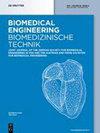Non-woven textiles for medical implants: mechanical performances improvement
IF 1.8
4区 医学
Q4 ENGINEERING, BIOMEDICAL
引用次数: 0
Abstract
Abstract Non-woven textile has been largely used as medical implant material over the last decades, especially for scaffold manufacturing purpose. This material presents a large surface area-to-volume ratio, which promotes adequate interaction with biological tissues. However, its strength is limited due to the lack of cohesion between the fibers. The goal of the present work was to investigate if a non-woven substrate can be reinforced by embroidery stitching towards strength increase. Non-woven samples were produced from both melt-blowing and electro-spinning techniques, reinforced with a stitching yarn and tested regarding several performances: ultimate tensile strength, burst strength and strength loss after fatigue stress. Several stitching parameters were considered: distance between stitches, number of stitch lines (1, 2 or 3) and line geometry (horizontal H, vertical L, cross X). The performance values obtained after reinforcement were compared with values obtained for control samples. Results bring out that reinforcement can increase the strength by up to 50% for a melt-blown mat and by up to 100% for an electro-spun mat with an X reinforcement pattern. However, after cyclic loading, the reinforcement yarn tends to degrade the ES mat in particular. Moreover, increasing the number of stitches tends to fragilize the mats.医用植入物用无纺布纺织品:机械性能改进
摘要在过去的几十年里,无纺布被广泛用作医用植入材料,特别是用于支架的制造。这种材料具有较大的表面积体积比,可促进与生物组织的充分相互作用。然而,由于纤维之间缺乏凝聚力,其强度受到限制。本工作的目的是研究是否可以通过刺绣缝合来增强非织造基板的强度。非织造布样品采用熔喷和电纺丝两种技术生产,并用缝线加固,并测试了几种性能:极限拉伸强度、破裂强度和疲劳应力后的强度损失。我们考虑了几个缝线参数:缝线之间的距离、缝线数(1、2或3)和线形(水平H、垂直L、交叉X)。将加固后得到的性能值与对照样本得到的值进行比较。结果表明,增强筋可使熔喷毡的强度提高50%,使X型增强筋的电纺毡的强度提高100%。然而,在循环加载后,增强纱尤其倾向于降解ES垫。此外,增加针脚的数量往往会使垫子变得脆弱。
本文章由计算机程序翻译,如有差异,请以英文原文为准。
求助全文
约1分钟内获得全文
求助全文
来源期刊
CiteScore
3.50
自引率
5.90%
发文量
58
审稿时长
2-3 weeks
期刊介绍:
Biomedical Engineering / Biomedizinische Technik (BMT) is a high-quality forum for the exchange of knowledge in the fields of biomedical engineering, medical information technology and biotechnology/bioengineering. As an established journal with a tradition of more than 60 years, BMT addresses engineers, natural scientists, and clinicians working in research, industry, or clinical practice.

 求助内容:
求助内容: 应助结果提醒方式:
应助结果提醒方式:


